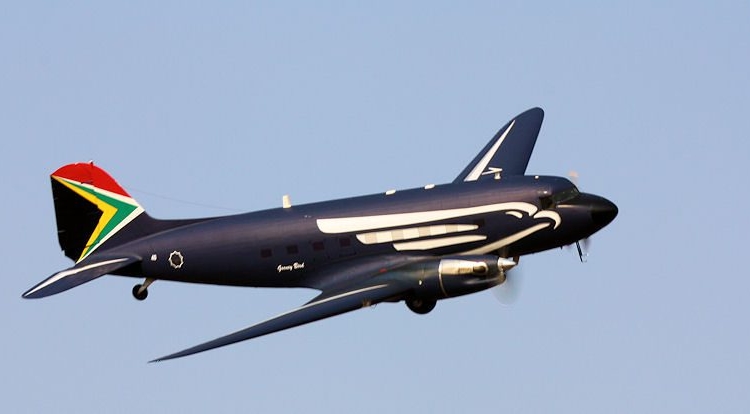The Douglas C-47 Dakota, known as the DC3 (C47) and affectionately referred to as the “workhorse of the air,” has been a symbol of South African aviation history. These enduring transport aircraft have been an integral part of the South African Air Force (SAAF) since their introduction in 1943. However, the beloved Dakotas may be nearing the end of their remarkable service as their future hangs in the balance.
On Solstice Day, the 21st of June in 1943, the SAAF took delivery of its first Douglas C-47 Skytrain, marking the beginning of a long and storied service history for this iconic aircraft.
For years, the SAAF held the distinction of operating the largest fleet of Dakotas globally, with 47 of these aging aircraft still serving their country. These resilient planes have been a fixture in various SAAF operations, providing steadfast support in transport and logistical missions.
For nearly 80 years the Douglas C-47 and its numerous derivatives has remained the most versatile working aircraft aviation has ever known. Designed and manufactured for American Airlines to out-compete operators using the Boeing 247 and Douglas DC-2, in the mid-1930’s Donald Douglas produced a larger and more luxurious version, the
DC-3.
However, the future of South Africa’s Dakotas seems increasingly uncertain as the South African Air Force grapples with maintenance and operational challenges that are raising concerns about the aircraft’s continued serviceability.
Armscor, South Africa’s state-owned defense company, has encountered difficulties in securing maintenance contracts for several SAAF aircraft types, and the situation is particularly challenging for the C-47TP variant of the Dakota. The lack of a maintenance solution has raised questions about whether this iconic aircraft might be permanently grounded.
In its presentation to Parliament’s Portfolio Committee on Defence and Military Veterans (PCDMV) in mid-September, Armscor expressed the challenges associated with maintaining the C-47TP Dakota fleet. It cited the age of the aircraft, indicating that because of this factor, the Dakota C-47TP is no longer supported by the original equipment manufacturer (OEM). Furthermore, there are no Aircraft Maintenance Organizations (AMOs) that include the Dakota C-47TP in their operational specifications.
Despite numerous attempts to secure a support contract for the C-47TP Dakota fleet since 2018, the quest has yielded no valid bids, resulting in several specification amendments and an ongoing dialogue between Armscor and the SAAF about the future of these vintage aircraft.
“The Dakota C-47TP is a very old aircraft, thus the support for this aircraft is very limited in South Africa and the world,” Armscor stated.
The Dakota’s journey in the South African Air Force dates back to World War II, during which the SAAF received a significant number of these aircraft, with serials ranging from 6801 to 6884. After the war, surplus Dakotas were either disposed of or transferred to the South African Airways, with some finding their way back to the SAAF in 1971, allocated the serial numbers 6885 to 6889.
However, the impending retirement of the Dakota from active service seems inevitable, especially given the challenges associated with maintaining an aging fleet. The aircraft has been an enduring symbol of the SAAF’s history and service, leaving an indelible mark on South African aviation.
As the SAAF contemplates the future of the Dakota, the aging yet cherished aircraft stands as a testament to the role it played in shaping the nation’s military and aviation history. It will always be remembered as a faithful and unwavering workhorse of the South African skies, reflecting the resilience and commitment of the SAAF over the decades.
Current state of the SAAF aircraft fleet
Similarly, the SAAF King Air, Caravan and C-47TP fleets do not have maintenance contracts in place. The South African Air Force (SAAF) has taken the decision to ground its fleet of Cessna 208 Caravan light transport aircraft, citing both age and funding constraints as contributing factors.
These high-wing, single-engined aircraft have faithfully served with the SAAF’s 41 Squadron, based at Air Force Base Waterkloof, since 1988 when they were originally purchased and integrated into the South African Air Force’s inventory. The SAAF uses the type as a light transport, aerial surveillance and electronic warfare (EW) platform. In 2007 the SAAF awarded a contract on Aerosud and Denel under Project Koiler for a day/night reconnaissance system for the C208. The SAAF received 13 Caravans from 1988, but four have been lost in accidents.
In December 2021, the South African Air Force (SAAF) temporarily grounded all of its Gripen multirole fighter fleet as none were serviceable. According to the Department of Defence (DoD), this is due to a lack of funding for maintenance, as support contracts were not renewed in time. However, in 2022, Saab received a support contract valued at R650 million for the service, repairs and maintenance of the Gripen airframes. Subsequently, South Africa has recently signed a contract with GKN Aerospace, a global engineering company, for the maintenance of the engines of its Gripen fighter jets.





